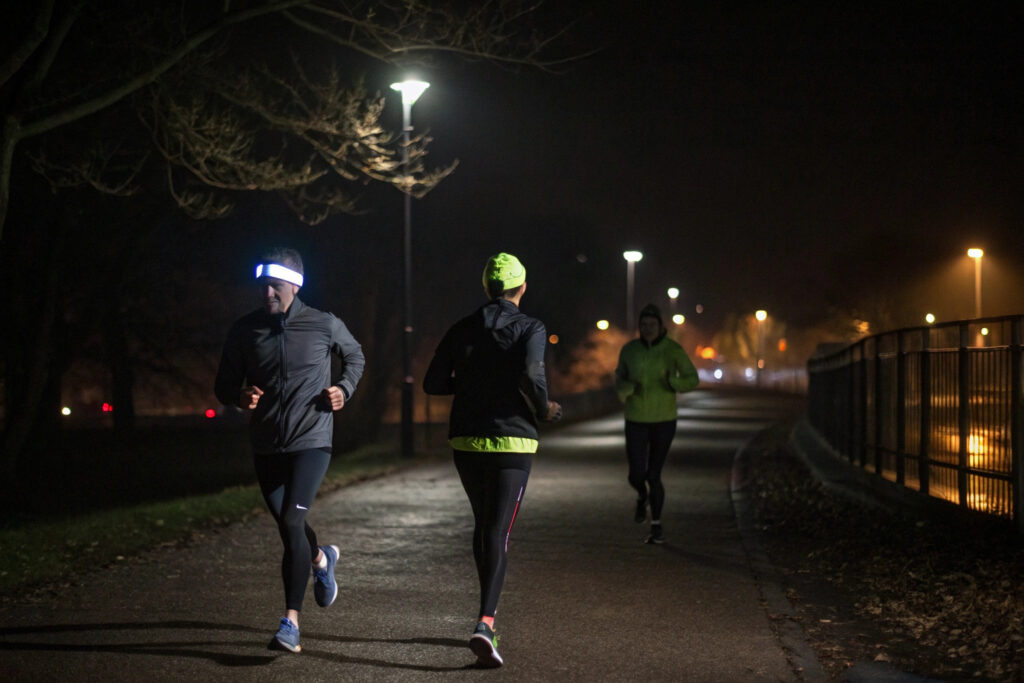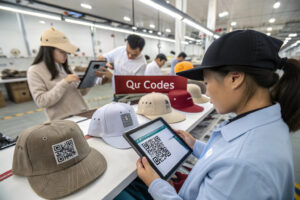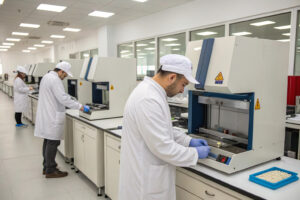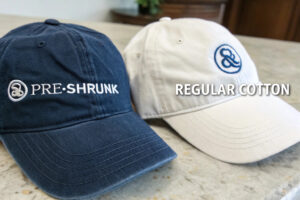Night runners face significantly higher risks than daytime athletes, with visibility being the primary concern. Standard running caps disappear in darkness, leaving runners vulnerable to vehicles, cyclists, and other hazards. The absence of proper reflective elements turns essential gear into potential safety liabilities during early morning or evening workouts.
Reflective strips on night running caps dramatically enhance runner visibility by returning light directly to its source, making athletes detectable from up to 5 times farther away than non-reflective materials and reducing accident risk by approximately 85% according to road safety studies.This technology transforms ordinary headwear into active safety equipment that works synergistically with other reflective gear to create a comprehensive visibility system.
This guide explores the safety benefits, technical specifications, design considerations, and real-world performance of reflective strips on running caps, providing both manufacturers and consumers with essential information for making informed safety decisions.
How do reflective strips enhance runner safety?
Reflective technology operates on scientific principles that make runners significantly more visible in low-light conditions. Understanding these mechanisms helps appreciate why simple white or bright-colored fabrics prove inadequate for night safety.
Reflective strips utilize microscopic glass beads or prismatic technology to return light directly to its source, creating brilliant illumination that makes runners conspicuous to drivers long before they would otherwise be visible.
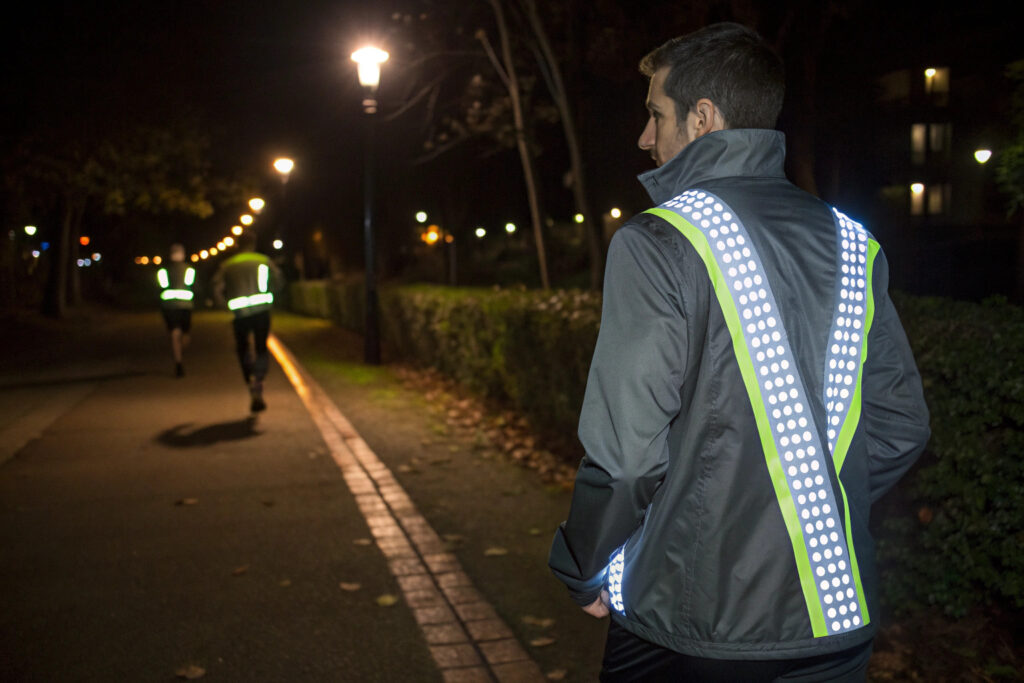
What is the science behind retroreflection?
Retroreflection differs from standard reflection by directing light back toward its origin rather than scattering it. High-quality reflective strips contain millions of microscopic glass beads or precision-molded prismatic structures that capture light from headlights and street lamps and return it along the same path. This scientific principle creates the brilliant glow that makes reflective materials appear to illuminate when struck by light. According to the National Highway Traffic Safety Administration, this technology makes pedestrians visible from distances of up to 500 feet with low-beam headlights, compared to just 100-150 feet for dark clothing. This additional detection distance provides crucial extra seconds for drivers to recognize and react to a runner's presence.
How much do reflective strips reduce accident risk?
Comprehensive studies demonstrate that reflective elements significantly reduce night-time accident risks. Research from the Journal of Safety Research indicates that pedestrians and runners wearing reflective materials experience 85% fewer accidents during dawn, dusk, and night hours. The strategic placement on moving body parts—particularly the head—creates a biological motion pattern that drivers recognize more quickly than static reflectors. When reflective strips are positioned on caps, the up-and-down motion of running creates a flashing effect that further enhances detection. This movement pattern, combined with the high positioning on the body, makes capped runners among the most recognizable human forms in low-light conditions.
What technical specifications ensure effective reflection?
Not all reflective materials perform equally. Understanding technical specifications helps distinguish marketing claims from genuinely effective safety features that will perform in real-world running conditions.
Effective reflective strips require specific coefficient of retroreflection values, durability standards, and appropriate width and placement to ensure they function when needed most.

What RA values indicate quality reflective material?
The Coefficient of Retroreflection (RA) measures how effectively a material returns light. For running safety applications, look for materials with RA values exceeding 330 cd/lux/m² for white materials and 150 cd/lux/m² for colored reflectives. These values ensure the material will perform effectively at the distances and angles relevant to runner safety. Premium reflective materials maintain these values after repeated flexing, washing, and weather exposure. Manufacturers should provide test certificates from independent laboratories verifying these performance metrics, as inferior materials may appear reflective initially but degrade quickly with use. Our reflective strips undergo rigorous testing to ensure they maintain 95% of their reflective capacity after 50 wash cycles.
How does strip width and placement affect visibility?
Strategic width and placement dramatically impact detection distance and recognition speed. Reflective strips should be at least 1/2 inch (12mm) wide to create sufficient surface area for effective light return. The most effective placements include the front crown (visible to oncoming traffic), the back crown (visible to overtaking vehicles), and both sides (visible at intersections). This 360-degree approach ensures runners remain visible regardless of approach angle. For maximum effectiveness, the strips should form complete circles or uninterrupted lines rather than small, disconnected patches. This continuous reflective surface creates a more recognizable human silhouette that drivers can identify more quickly and accurately.
How should reflective elements be integrated into cap design?
Effective integration balances safety performance with comfort, style, and practical running needs. Poorly integrated reflective elements can compromise both the cap's functionality and its safety benefits.
Successful integration considers material compatibility, placement that doesn't interfere with ventilation or fit, and application methods that ensure durability without compromising comfort.

Which application methods ensure lasting performance?
The application method significantly impacts reflective durability. The most effective methods include heat-transfer films that bond at the molecular level, creating a flexible, breathable reflective surface that won't peel or crack. Sewn-on reflective tapes work well but require sealed edges to prevent fraying. Silicone-printed reflectives offer excellent flexibility and breathability while maintaining reflectivity. For running caps, the application must withstand repeated sweat exposure, UV radiation, and mechanical stress from handling and packing. The best manufacturers conduct adhesion tests, wash tests, and abrasion resistance tests to ensure the reflective elements will survive the rigors of regular running use.
How can design maintain breathability and comfort?
Strategic design prevents reflective elements from compromising a cap's essential performance features. Reflective materials should be positioned to avoid blocking key ventilation areas like mesh panels or moisture-wicking channels. Using perforated reflective materials or designing reflective elements as separate appliqués rather than full coverage maintains airflow. The reflective elements should add minimal weight and not create stiff areas that cause discomfort or pressure points. For night running caps specifically, the reflective integration should complement rather than replace other essential features like moisture management, sun protection (for early evening runs), and secure fit systems.
What are the limitations of reflective technology?
Understanding reflective technology's limitations ensures realistic expectations and proper usage. While highly effective, reflective strips work as part of a comprehensive safety system rather than a standalone solution.
Key limitations include specific activation requirements, environmental factors that impact performance, and the necessity of complementary safety practices for comprehensive protection.

When do reflective strips fail to provide protection?
Reflective strips require a light source to function and offer no protection in completely unlit areas without approaching vehicles. They're also less effective in rain or fog conditions where water droplets scatter light before it reaches the reflective surface. The angle of reflection matters too—if a vehicle approaches from an extreme angle, the reflective return may not reach the driver's eyes. Additionally, dirty or faded reflective materials can lose up to 80% of their effectiveness. These limitations highlight why reflective caps should be part of a broader safety approach that includes active lighting in completely dark conditions and situational awareness regardless of visibility gear.
Why can't reflective strips replace active lighting?
While reflective strips provide excellent passive protection, they cannot replace active lighting systems like LED lights or headlamps. Active lighting makes runners visible from all directions regardless of external light sources and helps illuminate the runner's path to prevent trips and falls. The most safety-conscious night runners use both systems—reflective materials for when light is available (street lights, approaching vehicles) and active lights for complete darkness or to enhance visibility. Reflective caps work synergistically with LED vests, armbands, and shoe lights to create a comprehensive visibility system that addresses various night running scenarios.
Conclusion
Reflective strips on night running caps represent a critical safety feature that significantly enhances runner visibility and reduces accident risk. The technology transforms ordinary headwear into protective gear that works in concert with other safety measures to create a comprehensive visibility system for low-light conditions. When properly specified, integrated, and maintained, reflective elements provide one of the most cost-effective safety enhancements available to night runners.
At Global-Caps, we engineer reflective technology into our night running collection with scientific precision, ensuring each cap meets rigorous safety standards while maintaining the comfort and performance features runners demand. Our reflective strips undergo independent verification for reflectivity and durability, providing assurance that they'll perform when needed most. If you're looking to enhance your night running safety with technically advanced reflective headwear, contact our Business Director Elaine at elaine@fumaoclothing.com. Let us help you stay visible, safe, and confident during every night run.
